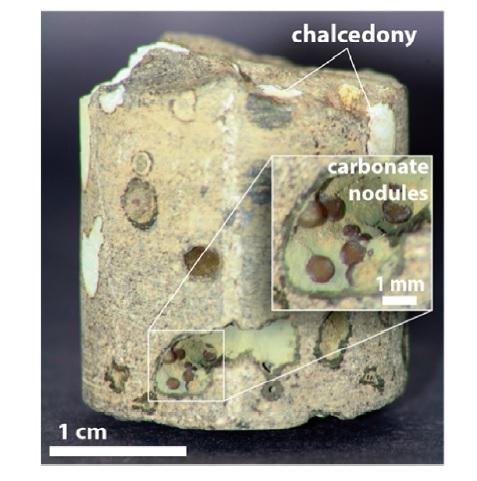Storing carbon dioxide underground by turning it into rock

A core sample from a carbon storage project in Washington state showed that carbon dioxide injected deep underground into basalt rock turned into the carbonate mineral ankerite in less than two years (inset). Credit: American Chemical Society
Lab studies on basalt have shown that the rock, which formed from lava millions of years ago and is found throughout the world, can rapidly convert CO2 into stable carbonate minerals.
This evidence suggests that if CO2 could be locked into this solid form, it would be stowed away for good, unable to escape into the atmosphere. But what happens in the lab doesn't always reflect what happens in the field.
One field project in Iceland injected CO2 pre-dissolved in water into a basalt formation, where it was successfully stored.
And starting in 2009, researchers with Pacific Northwest National Laboratory and the Montana-based Big Sky Carbon Sequestration Partnership undertook a pilot project in eastern Washington to inject 1,000 tons of pressurized liquid CO2 into a basalt formation.
After drilling a well in the Columbia River Basalt formation and testing its properties, the team injected CO2 into it in 2013.
Core samples were extracted from the well two years later, and Pete McGrail and colleagues confirmed that the CO2 had indeed converted into the carbonate mineral ankerite, as the lab experiments had predicted.
And because basalts are widely found in North America and throughout the world, the researchers suggest that the formations could help permanently sequester carbon on a large scale.
###
The authors acknowledge funding from the U.S. Department of Energy; the National Energy Technology Laboratory; the Big Sky Carbon Sequestration Partnership; Shell Exploration & Production Company; Portland General Electric; and Schlumberger Inc.
The paper's abstract will be available on Nov. 18 here: http://pubs.
The American Chemical Society is a nonprofit organization chartered by the U.S. Congress. With nearly 157,000 members, ACS is the world's largest scientific society and a global leader in providing access to chemistry-related research through its multiple databases, peer-reviewed journals and scientific conferences. Its main offices are in Washington, D.C., and Columbus, Ohio.
To automatically receive news releases from the American Chemical Society, contact newsroom@acs.org.
Media Contact
All latest news from the category: Materials Sciences
Materials management deals with the research, development, manufacturing and processing of raw and industrial materials. Key aspects here are biological and medical issues, which play an increasingly important role in this field.
innovations-report offers in-depth articles related to the development and application of materials and the structure and properties of new materials.
Newest articles

Recovering phosphorus from sewage sludge ash
Chemical and heat treatment of sewage sludge can recover phosphorus in a process that could help address the problem of diminishing supplies of phosphorus ores. Valuable supplies of phosphorus could…

Efficient, sustainable and cost-effective hybrid energy storage system for modern power grids
EU project HyFlow: Over three years of research, the consortium of the EU project HyFlow has successfully developed a highly efficient, sustainable, and cost-effective hybrid energy storage system (HESS) that…

After 25 years, researchers uncover genetic cause of rare neurological disease
Some families call it a trial of faith. Others just call it a curse. The progressive neurological disease known as spinocerebellar ataxia 4 (SCA4) is a rare condition, but its…





















